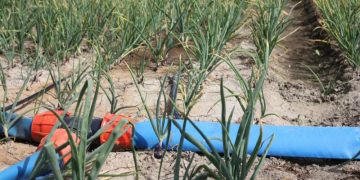Of the four traditional crops, onion fertigation ranks the highest. The results of seed onion fertigation trials are also encouraging this year.
A study by the Onion Innovation and Knowledge Center (UIKC) in Kolinsplaat, Zeeland shows that fertigation doubles the net yield of onions: 65 tons per hectare versus 30 tons per hectare without irrigation. Spraying the tree eight times gave a yield per hectare at the rate of 40 tons per hectare.
Fertigation can be more expensive than conventional irrigation, but due to higher yields, it can quickly fade away. Van Yperen calculated that onion growers could earn €3,150 more per hectare with fertigation than with conventional irrigation. The highest cost item is fertilizer, followed by drip tape, system costs, and installation and cleaning costs.
According to Van Iperen, the additional cost of fertigation is 1,850 euros compared to irrigation. With an onion price of 0.20 euro cents and a yield of 80 tons per hectare, fertijes yields 16,000 euros. Regular irrigation gives a yield per hectare of 55 tons, and at 0.20 euro cents, the financial return remains at 11,000 euros. €16,000 minus additional fertigation costs add up to €3,150 per hectare. Tonnages calculated by grower are averages of UIKC test results in 2020, 2021 and 2022.
Fertigatie biedt meer grip op gewas en geeft meer zekerheid en rendement
MIKEY AKKERMANS, FERTIGATIESPECIALIST VAN IPEREN
Van Yperen has many years of experience fertigating mainly onions and recently reported on results from Oude-Tong in the south of Holland. “Fertigation provides better grip on the crop, increases crop security and efficiency, provides better product quality and higher crop stability,” says fertigation specialist Mikey Ackermans.
Onions require between 150 and 250 millimeters of water, according to Van Iperen, depending on growing zone, planting stage, site and seasonality. This is more than, for example, potatoes, which can usually grow by 100-150 millimeters per hectare. Last growing season, due to a severe drought, the onion grower watered almost 300 millimeters in some trials. It is the art of fertilization as efficiently as possible with the help of water and fertilizers.
This requires optimal water intake and nutrition. Among other things, this is affected by the distance between the drops. The closer the hose is to the seed row, the more efficiently the water is used. The danger is that the outer rows are stunted because they receive less water. Akkermans advises laying one snake in two rows in an onion bed. On a bed of 1.5 meters there will be two snakes for four rows of onions.
Moisture after sowing
In addition, it is important to lay the hoses deep enough. ‘At least 5 centimeters. To do this, the seed bed is prepared deeper, so moistening after sowing is necessary. But if the hoses are too tight together, the drip holes can become clogged, the hoses will burst, or damage from overeating will occur.’
Akkermans reports that for a yellow onion with four seed units, 1 million seeds, an onion yield of 100 tons per hectare could theoretically be achieved. Due to various factors, this does not work in practice. What happened? In practice, water combined with fertilization has the greatest impact on yield. “Incorrect watering and fertilization can lead to crop losses of up to 40 percent,” says a grower.
Causes of yield decline
“It starts at the very beginning of cultivation. If the seeds do not germinate enough, the soil structure is not optimal and remains dry for a long time after sowing, you simply give up 30 tons of crop. Weeds, diseases and pests can lead to a reduction of up to 30 percent later in cultivation. In addition In addition, yields can be 20 percent lower due to salt damage.’
Incidentally, a 2022 UIKC drip irrigation test on the trial farm Rustchoeve in Kolinsplaat showed that salt water drip irrigation is indeed possible. When using only drip irrigation, fertilizers are not applied. The result of brackish water with an electrical conductivity (EC) value of 4 is almost the same as fresh water drip irrigation, reports Delphy on Onion Day in August.
EC value 8
Where onions dripped 60 millimeters at EC 4, the crop kept well despite the higher salt concentration. The subject showed the same leaf development and onion count as a comparable freshwater subject. In a CZAV drip test at a holiday farm, one field even had water dripping with an EC value of 8.































